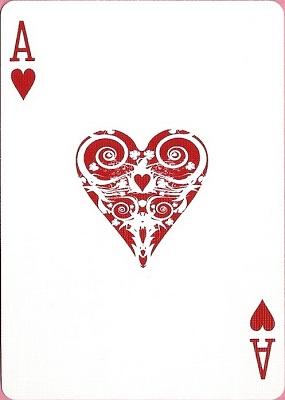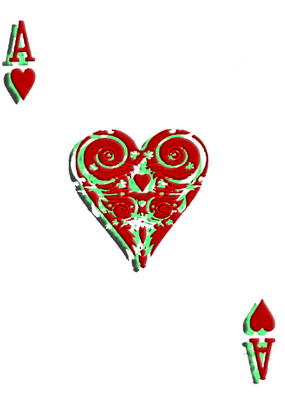






This is the same card that I edited in
PhotoShop and is now a PNG file.
Hearts |
|||
     |
 |
 |
|
This card that I found is a JPEG file. |
This is the same card that I edited in |
||
This is a children's game played in many parts of the world. No strategy is involved - simply the ability to recognise which of two cards is higher in rank, and to follow the procedure of the game. The standard two-player game is described first, then the game for three or four players, and finally a Russian version of it called Drunkard (P'yanitsa).
See also the War Variations page, for variations of War submitted by readers.
In the basic game there are two players and you use a standard 52 card pack. Cards rank as usual from high to low: A K Q J T 9 8 7 6 5 4 3 2. Suits are ignored in this game.
Deal out all the cards, so that each player has 26. Players do not look at their cards, but keep them in a packet face down. The object of the game is to win all the cards.
Both players now turn their top card face up and put them on the table. Whoever turned the higher card takes both cards and adds them (face down) to the bottom of their packet. Then both players turn up their next card and so on.
If the turned up cards are equal there is a war. The tied cards stay on the table and both players play the next card of their pile face down and then another card face-up. Whoever has the higher of the new face-up cards wins the war and adds all six cards face-down to the bottom of their packet. If the new face-up cards are equal as well, the war continues: each player puts another card face-down and one face-up. The war goes on like this as long as the face-up cards continue to be equal. As soon as they are different the player of the higher card wins all the cards in the war.
The game continues until one player has all the cards and wins. This can take a long time.
Most descriptions of War are not clear about what happens if a player runs out of cards during a war. There are at least two possibilities:
War can also be played by three or more players in much the same way. Deal out as many as possible of the cards so that everyone has an equal number (17 for 3 players, 13 for 4).
All players simultaneously turn over a card and the highest wins all the cards tuned up. If two or more players tie for highest there is a war - everyone plays their next card face-down and then turns up a third card. This continues until one of the face-up cards is higher than all the others, and then that player wins all the cards in a war.
Note that all players take part in a war, not only the ones who had the highest cards.
A player who runs out of cards drops out. The game goes on until only one player has cards, and that player wins.
© www.pagat.com